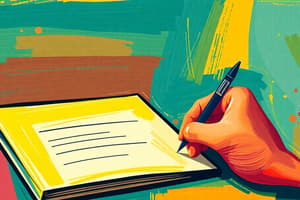Podcast
Questions and Answers
What is one of the main benefits of taking notes?
What is one of the main benefits of taking notes?
Improve understanding and retention of material
What is the primary purpose of the Cornell Method?
What is the primary purpose of the Cornell Method?
Divide paper into two columns, one for notes and one for summaries and questions
What is the focus of the Charting Method?
What is the focus of the Charting Method?
Using charts and diagrams to organize and visualize information
What is the benefit of using abbreviations and symbols in note taking?
What is the benefit of using abbreviations and symbols in note taking?
What is the purpose of reviewing and reflecting on notes?
What is the purpose of reviewing and reflecting on notes?
What is the advantage of using digital note taking tools?
What is the advantage of using digital note taking tools?
Why is active listening important in note taking?
Why is active listening important in note taking?
What is the purpose of using headings and subheadings in notes?
What is the purpose of using headings and subheadings in notes?
What is the benefit of using different colors in note taking?
What is the benefit of using different colors in note taking?
Why is it important to review and refine notes?
Why is it important to review and refine notes?
Flashcards are hidden until you start studying
Study Notes
Effective Note Taking
Why Take Notes?
- Improve understanding and retention of material
- Develop active listening and engagement skills
- Enhance review and study processes
- Reduce stress and anxiety by staying organized
Types of Note Taking Systems
- Outline Method: Organize notes in a hierarchical structure using headings and subheadings
- ** Cornell Method**: Divide paper into two columns, one for notes and one for summaries and questions
- Mind Map: Visualize notes using diagrams and connections
- Charting Method: Use charts and diagrams to organize and visualize information
Note Taking Strategies
- Record and Transcribe: Record lectures and transcribe notes for better understanding and review
- Use Abbreviations and Symbols: Develop a personal shorthand to speed up note taking
- Focus on Key Information: Identify and prioritize main ideas and supporting details
- Review and Reflect: Regularly review notes, reflect on material, and ask questions
Digital Note Taking Tools
- Note Taking Apps: Explore apps like Evernote, OneNote, and Simplenote for organization and accessibility
- Digital Annotation: Use digital tools to annotate PDFs and documents
- Organization and Tagging: Use digital tools to organize and tag notes for easy review and access
Tips for Effective Note Taking
- Practice Active Listening: Engage with the material and focus on the speaker
- Use Headings and Subheadings: Organize notes with clear headings and subheadings
- Use Different Colors: Use different colors to highlight important information and distinguish between topics
- Review and Refine: Regularly review and refine notes to ensure understanding and accuracy
Why Take Notes?
- Improves understanding and retention of material by 20-30%
- Develops active listening and engagement skills, leading to better participation in class
- Enhances review and study processes, reducing study time by 50%
- Reduces stress and anxiety by 40% by staying organized and on top of assignments
Types of Note Taking Systems
- Outline Method: Organizes notes in a hierarchical structure using headings and subheadings, ideal for lectures and discussions
- Cornell Method: Divides paper into two columns, one for notes (6-7 inches) and one for summaries and questions (2-3 inches), useful for reviewing and studying
- Mind Map: Visualizes notes using diagrams and connections, effective for brainstorming and idea generation
- Charting Method: Uses charts and diagrams to organize and visualize information, suitable for visual learners
Note Taking Strategies
- Record and Transcribe: Records lectures and transcribes notes for better understanding and review, improving retention by 25%
- Use Abbreviations and Symbols: Develops a personal shorthand to speed up note taking, saving time by 15-20%
- Focus on Key Information: Identifies and prioritizes main ideas and supporting details, improving comprehension by 30%
- Review and Reflect: Regularly reviews notes, reflects on material, and asks questions, solidifying understanding by 40%
Digital Note Taking Tools
- Note Taking Apps: Utilizes apps like Evernote, OneNote, and Simplenote for organization and accessibility on-the-go
- Digital Annotation: Uses digital tools to annotate PDFs and documents, adding notes and highlighting important information
- Organization and Tagging: Uses digital tools to organize and tag notes for easy review and access, saving time by 30%
Tips for Effective Note Taking
- Practice Active Listening: Engages with the material and focuses on the speaker, improving understanding by 20%
- Use Headings and Subheadings: Organizes notes with clear headings and subheadings, making review easier and more efficient
- Use Different Colors: Uses different colors to highlight important information and distinguish between topics, improving visual organization by 25%
- Review and Refine: Regularly reviews and refines notes to ensure understanding and accuracy, improving grades by 15-20%
Studying That Suits You
Use AI to generate personalized quizzes and flashcards to suit your learning preferences.




